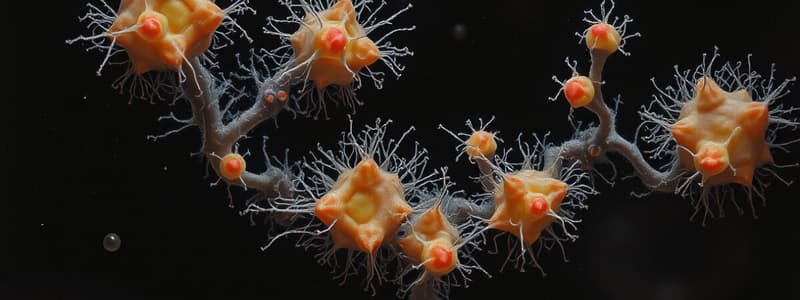Podcast
Questions and Answers
What distinguishes prokaryotic cells from eukaryotic cells?
What distinguishes prokaryotic cells from eukaryotic cells?
- Eukaryotic cells lack a nucleus.
- Prokaryotic cells do not have membrane-bound organelles. (correct)
- Prokaryotic cells are always multicellular.
- Eukaryotic cells reproduce asexually only.
Which group of microorganisms is primarily single-celled and lacks a nucleus?
Which group of microorganisms is primarily single-celled and lacks a nucleus?
- Helminths
- Archaea (correct)
- Eukarya
- Fungi
What is the primary method through which helminths are transmitted?
What is the primary method through which helminths are transmitted?
- Contact with contaminated surfaces.
- Ingestion of contaminated food or water. (correct)
- Direct contact with infected individuals.
- Aerosolized droplets.
Which of the following statements accurately describes pathogenic microorganisms?
Which of the following statements accurately describes pathogenic microorganisms?
What structure do bacteria commonly use for locomotion?
What structure do bacteria commonly use for locomotion?
Flashcards are hidden until you start studying
Study Notes
Microbiology and Microorganisms
- Microbiology is the study of microorganisms, which are microscopic entities including bacteria, archaea, viruses, fungi, algae, and protozoa.
- Microorganisms are categorized into three main groups: bacteria, archaea, and eukarya, based on cellular structures and genetic characteristics.
Groups of Microorganisms
- Bacteria: Unicellular prokaryotes that lack membrane-bound organelles; reproduce asexually through binary fission; have diverse metabolic capabilities.
- Archaea: Similar to bacteria in structure but genetically distinct; often found in extreme environments; possess unique lipid membranes and cell walls.
- Eukarya: Organisms characterized by eukaryotic cells that contain a nucleus; includes fungi, plants, animals, and protists; more complex than prokaryotes.
Prokaryotes vs. Eukaryotes
- Prokaryotes: Generally smaller and simpler; lack a nucleus and membrane-bound organelles; genetic material is a single circular chromosome; examples include bacteria and archaea.
- Eukaryotes: Larger and more complex; possess a nucleus and various membrane-bound organelles; genetic material is organized into multiple linear chromosomes; examples include fungi, plants, and animals.
Pathogens vs. Non-Pathogenic Microorganisms
- Pathogenic microorganisms: Cause disease in hosts; examples include pathogenic bacteria, viruses, and some fungi.
- Non-pathogenic microorganisms: Typically beneficial or neutral; play essential roles in processes like fermentation, nutrient cycling, and digestion.
Structures for Locomotion and Attachment
- Bacteria: Utilize structures like flagella for movement and pili (or fimbriae) for attachment to surfaces or host cells.
- Eukaryotic Cells: Use cilia and flagella for movement; have various adhesive proteins on surfaces to facilitate attachment.
Helminths
- Helminths are large, multicellular parasitic worms; classified into several groups, including flatworms (platyhelminths) and roundworms (nematodes).
- General life cycle often includes multiple stages such as eggs, larvae, and adult worms; may require intermediate hosts for development.
- Transmission methods include ingestion of eggs, direct contact with contaminated soil, or via vectors such as insects, depending on the type of helminth.
Studying That Suits You
Use AI to generate personalized quizzes and flashcards to suit your learning preferences.




